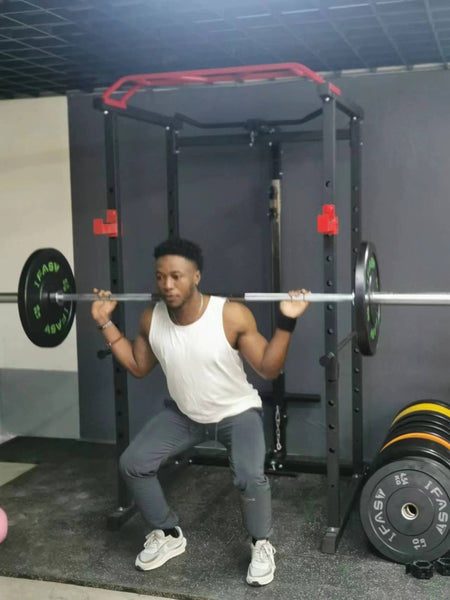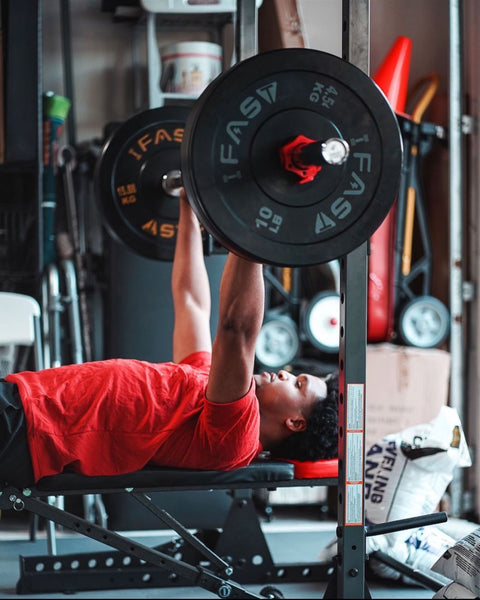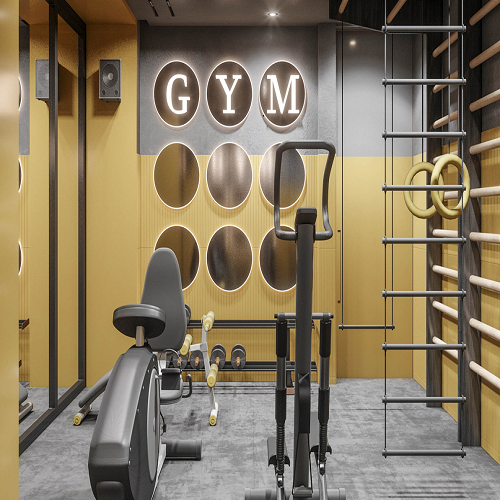
When it comes to building strength, muscle mass, and overall fitness, the battle between barbells and dumbbells has raged for decades. These two essential pieces of equipment have become staples in gyms and home gyms around the world, each offering its own unique benefits and drawbacks. While barbells are renowned for their ability to facilitate heavy compound lifts and maximize strength gains, dumbbells provide a valuable opportunity for unilateral training, improved stabilization demands, and targeted muscle development. The debate over which tool reigns supreme is a complex one, with the "best" choice often coming down to an individual's specific goals, preferences, and physical abilities.
By exploring factors such as stability, range of motion, muscle activation, and exercise variety, you'll gain valuable insights to make an informed decision about which equipment is best suited for your needs.
Understanding Barbells and Dumbbells
Before delving into the comparison between barbells and dumbbells, let's first understand what each equipment entails:
Barbells: Barbells are long, straight bars with weights attached to either end. They typically come in standard or Olympic sizes and allow for both bilateral (two-handed) and unilateral (one-handed) exercises. Barbells are versatile and can be used for a wide range of compound exercises, such as squats, deadlifts, bench presses, and rows.
Dumbbells: Dumbbells are handheld weights that come in various shapes, sizes, and materials. Unlike barbells, dumbbells are independent of each other, allowing for greater freedom of movement and unilateral training. Dumbbells are commonly used for both isolation and compound exercises, such as bicep curls, shoulder presses, lunges, and fly.
Benefits of Barbells
Barbells are the quintessential strength training tool, a staple in gyms and home setups worldwide. These long, rigid bars with weighted plates loaded on each end offer a range of benefits that make them a favorite among powerlifters, Olympic weightlifters, and strength athletes of all levels.

- Maximum Loading Potential One of the primary advantages of barbells is their ability to accommodate heavier loads than dumbbells. The stability of the bar and the ability to load substantial weight on each end allow for progressive overload, enabling lifters to continually challenge themselves and push their strength to new limits.
- Compound Movement Mastery Exercises like the barbell back squat, deadlift, and bench press are considered foundational compound movements that engage multiple major muscle groups simultaneously. Barbells excel in these lifts, allowing for efficient full-body training and optimal muscle and strength development.
- Improved Stabilization and Core Engagement While barbells provide a stable base for the load, they still require significant stabilization from your core muscles and smaller stabilizers to maintain proper form and control. This increased core engagement can lead to improved overall strength and stability, benefiting both athletic performance and functional fitness.
- Convenient Weight Progression The ability to add or remove weighted plates in incremental amounts (e.g., 2.5 lbs, 5 lbs) makes barbells an excellent choice for progressive overload. This allows lifters to gradually increase the weight over time, avoiding plateaus and continuously challenging their muscles.
Benefits of Dumbbell
While barbells have their place in strength training, dumbbells offer a unique set of benefits that make them a valuable addition to any well-rounded program.

- Increased Stabilization Demands Unlike barbells, where the weight is distributed evenly across a rigid bar, dumbbells require independent stabilization for each arm or leg. This increased demand on smaller stabilizer muscles can lead to improved overall body control, coordination, and muscle activation.
- Unilateral Training Opportunities Dumbbell exercises often involve working one arm or leg at a time, making them ideal for addressing and correcting muscular imbalances or strength disparities between limbs. Unilateral training can also help improve functional strength and mimic real-world movement patterns.
- Greater Range of Motion The freedom of movement afforded by dumbbells allows for a greater range of motion in many exercises, potentially leading to increased muscle fiber recruitment and enhanced hypertrophy (muscle growth).
- Versatility and Exercise Selection Dumbbells offer a vast array of exercise possibilities, from traditional compound movements like dumbbell presses and rows to more isolated exercises like bicep curls and lateral raises. This versatility allows for targeted muscle development and the ability to tailor workouts to specific goals.
- Improved Grip Strength The inherent instability of dumbbells requires constant grip engagement, which can lead to improved grip strength over time. Strong grip strength is essential for various strength and functional movements, as well as everyday tasks.
Choosing the Right Tool for Your Goals
When deciding between barbells and dumbbells, it's essential to consider your specific training goals and individual needs.
Barbells may be the preferred choice for:
- Powerlifters and strength athletes focused on maximizing strength in the big three lifts (squat, bench press, deadlift)
- Individuals seeking to build overall full-body strength and muscle mass efficiently
- Those with limited equipment space or a home gym setup, where barbells can provide a more comprehensive workout with fewer pieces of equipment
Dumbbells may be the better option for:
- Bodybuilders and physique athletes looking to isolate and target specific muscle groups for hypertrophy
- Individuals with existing strength imbalances or mobility limitations that require unilateral training
- Those seeking to improve overall body control, coordination, and functional strength
- Situations where space or equipment availability is limited, as dumbbells offer a more compact and versatile solution
Combining Barbells and Dumbbells
Combining barbells and dumbbells in your training routine can be done in various ways to maximize your strength training and muscle-building efforts. Here are some strategies and exercises to help you effectively combine barbells and dumbbells:
1.Compound Exercises with Barbells
Start your workout with compound exercises using a barbell to target multiple muscle groups simultaneously. Some examples include:
- Barbell Squats: Place the barbell on your upper back and perform squats, engaging your quadriceps, hamstrings, glutes, and core.
- Barbell Deadlifts: Load the barbell with an appropriate weight and perform deadlifts, activating your posterior chain muscles, including the hamstrings, glutes, and lower back.
- Barbell Bench Press: Lie back on a weight bench and lift the barbell from a rack, lowering it to your chest and pressing it back up, targeting your chest, shoulders, and triceps.

2.Unilateral Exercises with Dumbbells
Incorporate unilateral exercises using dumbbells to work on imbalances and engage stabilizer muscles. Some examples include:
- Dumbbell Lunges: Hold a dumbbell in each hand and step forward into lunges, targeting your quadriceps, hamstrings, and glutes.
- Dumbbell Single-Arm Rows: Place one hand and knee on a bench, hold a dumbbell in the opposite hand, and row it upward, targeting your back muscles, including the lats and rhomboids.
- Dumbbell Overhead Press: Hold dumbbells at shoulder height and press them overhead, engaging your shoulders and triceps.
3.Combination Exercises
Perform exercises that combine barbells and dumbbells to stimulate different muscle groups and movement patterns. Some examples include:
- Barbell Squat to Dumbbell Shoulder Press: Start with a barbell squat and, as you stand up, transition into a shoulder press with dumbbells. This exercise targets your lower body and shoulders.
- Barbell Bench Press with Dumbbell Fly: After completing a set of barbell bench presses, grab a pair of dumbbells and perform fly to further engage your chest muscles.
- Barbell Romanian Deadlift with Dumbbell Bicep Curls: Perform a set of barbell Romanian deadlifts, targeting your hamstrings and glutes. Then, grab a pair of dumbbells and perform bicep curls to target your biceps.
4.Superset and Alternating Sets
Combine barbell exercises with dumbbell exercises in superset or alternating sets to increase intensity and save time. For example:
- Superset: Perform a set of barbell squats immediately followed by a set of dumbbell lunges without rest. Rest for a short period before repeating the superset.
- Alternating Sets: Alternate between sets of barbell bench press and dumbbell chest flyes, resting briefly between each set. This allows you to target the same muscle group using different equipment.
5.Periodization
Incorporate periodization into your training program by alternating between phases that focus more on barbell exercises and phases that emphasize dumbbell exercises. For example, during a strength phase, prioritize heavy barbell lifts, and during a hypertrophy phase, incorporate a mix of compound barbell exercises and isolation dumbbell exercises.
Remember to adjust the weights and repetitions based on your fitness level and goals. Focus on maintaining proper form and technique throughout your workouts to minimize the risk of injury.
By combining barbells and dumbbells strategically in your training routine, you can benefit from the advantages of both types of equipment, such as compound movements, unilateral training, exercise variety, and progressive overload. This approach can help you achieve well-rounded development and optimize your strength and muscle-building progress.
Conclusion
Barbells and dumbbells are valuable tools in strength training and muscle building.The choice between barbells and dumbbells depends on your goals, fitness level, and exercise preferences. However, combining both equipment in your training routine can provide the best of both worlds, allowing you to maximize the benefits of each. By utilizing barbells and dumbbells strategically and incorporating progressive overload, exercise variety, and periodization, you can optimize your strength training and muscle building journey.
Barbells excel in stability, load capacity, and compound movements, making them ideal for strength development.
Dumbbells offer greater range of motion, improved core activation, and versatility in targeting specific muscle groups.
FAQs
Q: Which is better for beginners: barbells or dumbbells?
A: Both barbells and dumbbells can be suitable for beginners, but it depends on your specific goals and preferences. Barbells are often recommended for beginners due to their stability and suitability for compound exercises that build overall strength. Dumbbells, on the other hand, can be beneficial for beginners to work on unilateral strength, muscle imbalances, and coordination. It's generally a good idea to include a mix of both in your training routine to reap the benefits of both types of equipment.
Q: Can I use both barbells and dumbbells in the same workout?
A: Absolutely! In fact, combining barbells and dumbbells in the same workout can be highly effective. You can start your workout with compound barbell exercises to target major muscle groups, and then incorporate dumbbell exercises to focus on specific muscle groups, unilateral training, or isolation exercises. This approach allows for exercise variety, muscle balance, and efficient use of both types of equipment.
Q: Are barbells or dumbbells better for injury prevention?
A: Both barbells and dumbbells can be used for injury prevention, depending on the specific exercise and individual circumstances. Barbells, with their fixed grip and stability, can be advantageous for beginners or individuals with limited stability, as they provide a secure grip and controlled movement. Dumbbells, on the other hand, can be useful for addressing muscle imbalances and promoting joint stability through unilateral training. It's important to use proper form, start with manageable weights, and progress gradually to minimize the risk of injury.
Q: Are dumbbells sufficient if I can't access barbells?
A: Yes, you can build an effective strength program with just dumbbells if barbells aren't available. Find dumbbell variations of key lifts like squats, presses, rows, and deadlifts.
Q: How much weight difference is typical between barbell and dumbbell lifts?
A: Most people can lift 20-40% more on barbell lifts than their dumbbell counterparts due to the stability and leverages involved.
Q: Can I use barbells and dumbbells for cardiovascular exercise?
A: While barbells and dumbbells are primarily used for strength training, they can also be incorporated into cardiovascular workouts. For example, exercises like barbell complexes or dumbbell circuits that involve performing a series of exercises back-to-back with minimal rest can elevate your heart rate and provide a cardiovascular challenge. Additionally, incorporating explosive movements such as barbell or dumbbell snatches and cleans can increase the intensity and cardiovascular demands of your workout. However, traditional cardio exercises like running or cycling are typically better suited for cardiovascular training.


